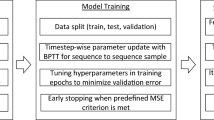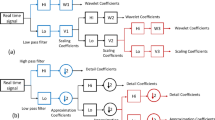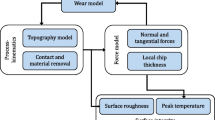Abstract
Accurate prediction of machine tool wear is an essential part of modern and efficient manufacturing. In recent years, many studies have been carried out using machine learning algorithms, both traditional and deep learning; with the latter ones reporting the highest precisions. The present work aims to show that, in the tool wear prediction problem, traditional methods can have a performance similar to the state of the art, obtained using deep learning methods. The data used here is presented in the form of time series, which cannot be used directly by traditional machine learning algorithms, such as the ones used in this work. To link the raw data and the learning algorithm, it is first necessary to extract a set of features from the time series. In addition, some preprocessing techniques, Bayesian hyperparameter optimization and forward feature selection are applied. In this work, two freely accessible databases are used with two different but related objectives, the first is used to predict machine tool wear, while the second is used to predict the remaining useful life of machine tools. For the first case, errors (RMSE) of less than 10 were obtained, while in the second case scores above 85% were achieved. In both cases, these results are comparable to the state of the art. Using the methodology presented here makes it possible to obtain very accurate tool wear predictions at a lower computational cost, both due to the use of less complex models and to a reduced set of features.















Similar content being viewed by others
Availability of data and materials
The data used in the present work corresponds to the 2010 PHM Society Conference Data Challenge and the 1st Foxconn industrial AI Data Challenge, available at https://www.phmsociety.org/competition/phm/10 and https://www.iaiinstitute.com/competitions/17/eventIntroduction, respectively.
Notes
2010 PHM Society Conference Data Challenge https://www.phmsociety.org/competition/phm/10
1st Foxconn industrial AI Data Challenge https://iaiinstitute.com/competitions/17/eventIntroduction.
References
Kalpakjian S, Schmid SR (2013) Manufacturing engineering and technology. Pearson, London
Xu H, Zhang C, Hong GS, et al (2018) Gated recurrent units based neural network for tool condition monitoring. In: 2018 international joint conference on neural networks (IJCNN). IEEE, pp 1–7
D’Addona DM, Matarazzo D, Sharif Ullah AM, Teti R (2015) Tool wear control through cognitive paradigms. Procedia CIRP 33:221–226
Kurada S, Bradley C (1997) A review of machine vision sensors for tool condition monitoring. Comput Ind 34:55–72
Zhou Y, Xue W (2018) Review of tool condition monitoring methods in milling processes. Int J Adv Manuf Technol 96:2509–2523
Karandikar J, McLeay T, Turner S, Schmitz T (2015) Tool wear monitoring using naïve Bayes classifiers. Int J Adv Manuf Technol 77:1613–1626
Vetrichelvan G, Sundaram S, Senthil Kumaran S, Velmurugan P (2015) An investigation of tool wear using acoustic emission and genetic algorithm. J Vib Control 21:3061–3066
Teti R (2002) Machining of composite materials. CIRP Ann 51:611–634
Sick B (2002) On-line and indirect tool wear monitoring in turning with artificial neural networks: a review of more than a decade of research. Mech Syst Signal Process 16:487–546
Dutta S, Kanwat A, Pal SK, Sen R (2013) Correlation study of tool flank wear with machined surface texture in end milling. Measurement 46:4249–4260
Ghosh N, Ravi YB, Patra A et al (2007) Estimation of tool wear during CNC milling using neural network-based sensor fusion. Mech Syst Signal Process 21:466–479
Drouillet C, Karandikar J, Nath C et al (2016) Tool life predictions in milling using spindle power with the neural network technique. J Manuf Process 22:161–168
Teti R, Micheletti GF (1989) Tool wear monitoring through acoustic emission. CIRP Ann 38:99–102
Rubio EM, Teti R (2009) Cutting parameters analysis for the development of a milling process monitoring system based on audible energy sound. J Intell Manuf 20:43–54
Karam S, Centobelli P, D’Addona DM, Teti R (2016) Online prediction of cutting tool life in turning via cognitive decision making. Procedia CIRP 41:927–932
Caggiano A, Napolitano F, Teti R (2017) Dry turning of Ti6Al4V: tool wear curve reconstruction based on cognitive sensor monitoring. Procedia CIRP 62:209–214
Caggiano A, Napolitano F, Nele L, Teti R (2018) Multiple sensor monitoring for tool wear forecast in drilling of CFRP/CFRP stacks with traditional and innovative drill bits. Procedia CIRP 67:404–409
Caggiano A, Angelone R, Napolitano F et al (2018) Dimensionality reduction of sensorial features by principal component analysis for ANN machine learning in tool condition monitoring of CFRP drilling. Procedia CIRP 78:307–312
Caggiano A, Centobelli P, Nele L, Teti R (2017) Multiple sensor monitoring in drilling of CFRP/CFRP stacks for cognitive tool wear prediction and product quality assessment. Procedia CIRP 62:3–8
Wang J, Xie J, Zhao R et al (2017) Multisensory fusion based virtual tool wear sensing for ubiquitous manufacturing. Robot Comput Integr Manuf 45:47–58
Avci O, Abdeljaber O, Kiranyaz S et al (2021) A review of vibration-based damage detection in civil structures: from traditional methods to machine learning and deep learning applications. Mech Syst Signal Process 147:107077
Zhao R, Yan R, Chen Z et al (2019) Deep learning and its applications to machine health monitoring. Mech Syst Signal Process 115:213–237
Huang C-G, Yin X, Huang H-Z, Li Y-F (2020) An enhanced deep learning-based fusion prognostic method for RUL prediction. IEEE Trans Reliab 69:1097–1109
Liu H, Liu Z, Jia W et al (2020) A novel transformer-based neural network model for tool wear estimation. Meas Sci Technol 31:065106
Qiao H, Wang T, Wang P et al (2018) A time-distributed spatiotemporal feature learning method for machine health monitoring with multi-sensor time series. Sensors 18:2932
Zhao R, Yan R, Wang J, Mao K (2017) Learning to monitor machine health with convolutional bi-directional LSTM networks. Sensors 17:273
Wang J, Yan J, Li C et al (2019) Deep heterogeneous GRU model for predictive analytics in smart manufacturing: application to tool wear prediction. Comput Ind 111:1–14
Zhao R, Wang D, Yan R et al (2018) Machine health monitoring using local feature-based gated recurrent unit networks. IEEE Trans Ind Electron 65:1539–1548
Vapnik V (2000) The nature of statistical learning theory. Springer, New York
Vapnik VN (1999) An overview of statistical learning theory. IEEE Trans Neural Netw 10:988–999
Rasmussen CE, Williams CKI (2005) Gaussian processes for machine learning. The MIT Press, Cambridge
Breiman L (2001) Random forests. Mach Learn 45:5–32
Aggarwal CC (2015) Data mining. Springer International Publishing, Berlin
Friedman JH (2002) Stochastic gradient boosting. Comput Stat Data Anal 38:367–378
Chen T, Guestrin C (2016) XGBoost: a scalable tree boosting system. In: Proceedings of the 22nd ACM SIGKDD international conference on knowledge discovery and data mining, pp 785–794
Ke G, Meng Q, Finley T et al (2017) Lightgbm: a highly efficient gradient boosting decision tree. In: Advances in neural information processing systems, pp 3146–3154
Bergstra JS, Bardenet R, Bengio Y, Kégl B (2011) Algorithms for hyper-parameter optimization. In: 25th annual conference on neural information processing systems (NIPS 2011), pp 2546–2554
Hyndman RJ, Athanasopoulos G (2018) Forecasting: principles and practice. OTexts, Austin
Li X, Lim BS, Zhou JH et al (2009) Fuzzy neural network modelling for tool wear estimation in dry milling operation. In: Annual conference of the prognostics and health management society, pp 1–11
Christ M, Braun N, Neuffer J, Kempa-Liehr A (2018) Time series feature extraction on basis of scalable hypothesis tests (tsfresh—a Python package). Neurocomputing 307:72–77
Duboue P (2020) The art of feature engineering: essentials for machine learning. Cambridge University Press, Cambridge
Liu C, Zhang L, Niu J et al (2020) Intelligent prognostics of machining tools based on adaptive variational mode decomposition and deep learning method with attention mechanism. Neurocomputing 417:239–254
Casusol AJ, Zegarra FC, Vargas-Machuca J, Coronado AM (2021) Optimal window size for the extraction of features for tool wear estimation. In: 2021 IEEE XXVIII international conference on electronics, electrical engineering and computing (INTERCON)
Funding
This work was funded by CONCYTEC-FONDECYT in the framework of call E038-01, grant No. 020-2019-FONDECYT-BM-INC.INV.
Author information
Authors and Affiliations
Contributions
FCZ preprocessed the data, developed the training algorithms, analysed the results and wrote the manuscript, JV performed the feature extraction, analysed the results and wrote the manuscript, AMC devised the project, performed the preliminary analysis and wrote the manuscript.
Corresponding author
Ethics declarations
Conflict of interest
The authors declare no conflict of interest.
Ethical approval
No human participants or animals were involved in this study.
Consent to participate
No human participants or animals were involved in this study.
Consent to publish
No human participants or animals were involved in this study.
Additional information
Publisher's Note
Springer Nature remains neutral with regard to jurisdictional claims in published maps and institutional affiliations.
Rights and permissions
About this article
Cite this article
Zegarra, F.C., Vargas-Machuca, J. & Coronado, A.M. Tool wear and remaining useful life (RUL) prediction based on reduced feature set and Bayesian hyperparameter optimization. Prod. Eng. Res. Devel. 16, 465–480 (2022). https://doi.org/10.1007/s11740-021-01086-8
Received:
Accepted:
Published:
Issue Date:
DOI: https://doi.org/10.1007/s11740-021-01086-8




